The 10 Best Video Monetization Platforms in 2026
Video monetization platforms continue to create a variety of new business opportunities as skyrocketing growth has normalized into the widespread adoption of live streaming video in every format on every device.
Streaming research shows that digital video ad spend is projected to reach $72 billion in 2025, a 14 % increase over 2024, and will account for nearly 60 % of all TV/video ad spend. Meanwhile, the global video streaming market is forecast to expand from $811 billion in 2025, with overall valuation expected to reach $2.66 trillion by 2032. Additionally, live streaming now drives notable engagement—27.7% of global weekly video consumption—and viewership surged 128% in Q1 2024 compared to Q1 2019.
That’s great news for broadcasters passionate about bringing their content to the world stage and those who wish to make video creation their full-time careers. Today’s content creators have a diverse toolbox of software and video monetization platforms—including Dacast as a leading monetization platform and a benchmark for evaluating others. You can magnetize views and earn a living through video monetization if you have a unique perspective to share with the world.
The upsurge in video monetization options presents an opportunity for organizations to monetize their video libraries and create stable streams of recurring income. From ad-supported content and viewer subscriptions to pay-per-view (PPV) and on-demand services, monetization is the new standard of profitable media delivery and consumption.
All these choices can make selecting the right video monetization platform overwhelming for broadcasters, both newbies and veterans.
This article will explain how video monetization works and look at various video monetization models (AVOD, SVOD, and TVOD) proven to work for video creators like you.
We also look at how these can be used with both live streaming and video on demand. And, we touch upon paywalls and review the best video monetization platforms—including Dacast—and streaming services of 2026.
Hopefully, this blog will help you make informed decisions about all the Dacast monetization options available to you, and the things you must keep in mind to maximize video monetization opportunities for your content.
The technology that video monetization platforms rely on is changing all the time. This post has been updated to reflect the most accurate information on the best video monetization platforms as of Nov 2025.
Table of Contents
- What is Video Monetization?
- Proven Strategies to Maximize Video Monetization
- How to Monetize Videos in 2026
- How to Monetize Videos Without YouTube
- What is a Video Paywall?
- Quick Overview of the 10 Best Video Monetization Platforms
- Comparing All-in-One Platforms: Dacast vs. Other Solutions
- 8 Things to Consider When Choosing a Secure Video Monetization Platform
- Future Video Monetization Trends
- FAQs
- Dacast is Your Top Choice for Monetizing Live and On-Demand Content
What is Video Monetization?
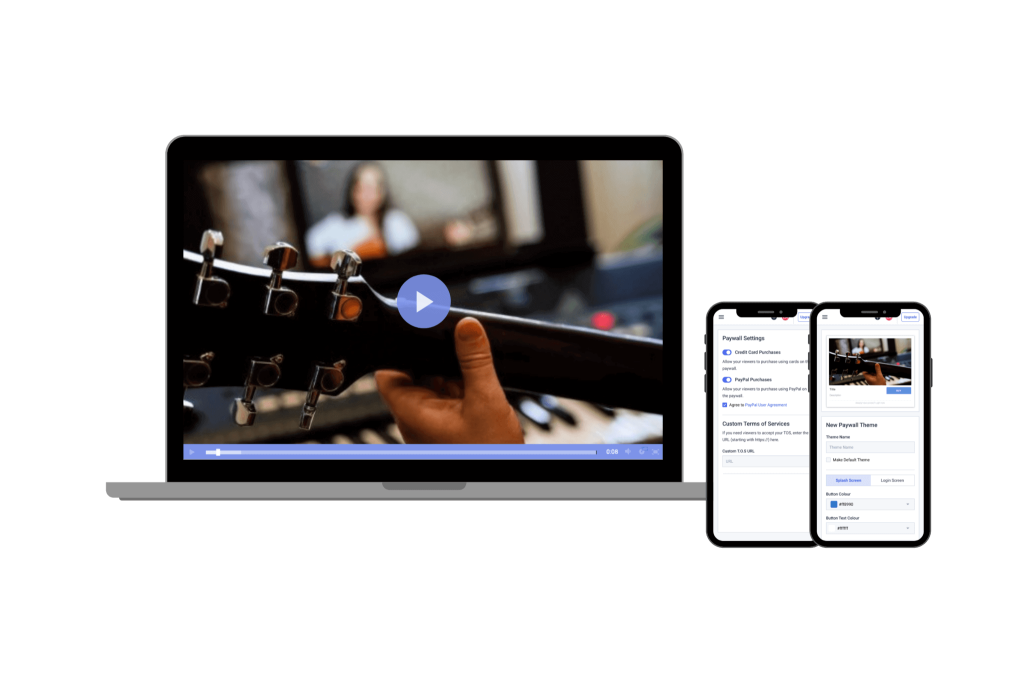
Video monetization means getting paid for the videos you publish online. Not so much for the creation but rather when audiences view or download your content. The more people watch, the greater your earnings from your videos are.
Broadcasters can generate revenue from their videos in many different ways. The most common include:
- Inserting ads
- Incorporating sponsors
- Offering subscriptions
- Creating product reviews
- Service reviews
- Asking users to pay to watch
Generating income from your videos is based on these distinct video streaming business models:
- Access to unique content: When you serve the needs of your audience well, followers will pay to view the content you create. Educational curricula, training courses, and other digital downloads are prime examples.
- Access to your audience: Advertisers with a product or service (that aligns with your brand) will sponsor ads or pay for placement within your video content. Think about promoting workout gear or supplements to a fitness audience or running team apparel ads during a live sports event.
- Access to your shoppable video platform: As a broadcaster, creating a subscription model to access premium content – or your entire video-on-demand library – is a smart monetization play. That model works especially well for media agencies, online publishers, and others with vast content collections that are already established.
Some organizations may hesitate to charge fees or subscriptions for premium content, believing that such actions will be perceived negatively or turn away loyal visitors. However, in the case of most brands, the opposite is true.
Utilizing the best ways to monetize videos doesn’t have to spell doom for your vision as a brand or organization.
Learning how to monetize videos and focusing on delivering value-added content is a surefire strategy to increase revenue for any brand. Remember that if the information you provide is valuable and compelling, viewers will gladly pay to benefit from it, especially if the content is entertaining, solves a problem, or helps viewers grow.
Video Monetization Stats and Facts
Are you still trying to determine if a video monetization strategy is worth the hassle for your brand? The best way to understand the true potential that video monetization unlocks is by seeing the stats.
Here are a few interesting trends in video monetization:
- The online video industry is forecasted to be worth $416.84 billion by the year 2030
- Experts expect the total value of global video subscriptions to reach $338 million this year
- Over half of the viewers report that they’d rather watch a live stream with ads rather than pay a subscription fee
- The median U.S. household now contains an average of five streaming devices, with 18% having ten or more
- 76% of US broadband homes now have OTT subscriptions
- Ad revenue from SVOD, the primary OTT revenue source, will grow from $19 billion in 2023 to $127 billion by 2029
Want to learn more about the general online video streaming video business and landscape? Check out our live-streaming video courses and statistics post to review 100+ stats and trends.
Common Video Monetization Models
Although broadcasters can monetize video content in dozens of ways, most efforts fall within one of three main OTT monetization models: AVOD, SVOD, or TVOD. While all of them can be profitable, each one has its pros and cons. Plus, you may change your video monetization method over time depending on where you are in your video business life cycle.
Advertising-Based Video On Demand (AVOD)
AVOD is a classic monetization model where brands pay to run ads in your videos, offering creators easy setup, broad audience reach, and revenue potential that scales with viewership.
AVOD Advantages:
- Most suitable for creators and publishers who want to promote their content online to a broad audience.
- High viewership
- Low risk
- Incentives
- improved ad targeting
- Perfect for offering consumers free and instantly accessible content.
AVOD Disadvantages:
- Potential poor user experience
- Risk of viewer retention rate decrease
- Revenue isn’t guaranteed
- Difficult measuring of ad’s impact
2026 Application:
Best for news networks or viral content creators leveraging AI-powered ad targeting for streaming platforms to maximize revenue without charging viewers.
Subscription-Based Video On Demand (SVOD)
SVOD is a profitable model where viewers pay recurring fees for unlimited access to on-demand or live-streaming content, enabling creators to build steady recurring revenue.
SVOD Advantages:
- Most suitable for video content creators and broadcasting platforms who want to offer consumers a convenient, ad-free user experience.
- Allows for a steady, recurring, predictable income stream.
- Gives you full control over content distribution and monetization.
- Promotes streamers’ stability and growth by supporting the building of a fan base.
- Supports paywall monetization, thus, ensuring that users access only content they pay for.
SVOD Drawbacks:
- High churn rate: Users can unsubscribe from a service whenever they want.
- Smaller audience reach.
- Requires a large video library to attract new subscribers and keep the existing ones interested.
2026 Application:
Ideal for niche educational platforms using AI-personalized learning paths and content libraries to retain long-term subscribers.
Transactional Video On Demand (TVOD)
TVOD, or pay-per-view, is a model where viewers pay per video or event, making it ideal for premium or niche content that audiences are willing to purchase individually.
TVOD Advantages:
- Perfect for new, small businesses. It’s a great starting point for new streaming platforms and creators and allows them to scale with time.
- Fixed cost, which allows you to calculate how much you’ll spend on it each month.
- Increased income for new releases.
- Easy-to-track revenue distribution since your customers pay for specific video content.
- Flexible pricing – different prices for rented and bought content.
TVOD Challenges:
- No free preview or trial, which may discourage some users from renting or buying content from your platform.
- Increased competition.
- Risk of quickly losing customers since they pay for a specific content piece and can leave your site and never come back.
- Not suitable for users who consume a lot of content.
2026 Application:
Perfect for creators launching exclusive AI-generated films, live concerts, or sports events with premium pricing and limited-time access.
Proven Strategies to Maximize Video Monetization
Regardless of which video monetization model you use, there’s always room for improvement. Here are several tips to help you maximize profits from any model.
Cross-Model Tips for Maximizing Profit
1. Data-driven targeting and personalization
Improve audience and ad targeting by using data analytics to identify and understand users’ interests and preferences. Use that data to serve them relevant video content to increase user retention and engagement and build a loyal fan base. Also, use the gathered info to offer a personalized experience by sending targeted promotions or discounts for the content categories users are most interested in.
2. Offer content bundles
Offering two or more pieces of content together at a slightly lower price than when bought separately allows them to save some money while enjoying their favorite content. At the same time, it helps you maintain users’ interest in seasonal content and its demand on a satisfying level.
3. Combine monetization models
SVOD + AVOD is a winning video monetization strategy for maximizing success and profit. It allows you to offer free content with ads and premium ad-free content on a subscription base. This approach will reduce the churn rate and keep users interested by giving them the chance to choose (and switch between) between a free and paid service.
4. Offer discounts and coupons for new and loyal subscribers
This method helps boost audience engagement and leads to more purchases. Netflix did the same back then – they gave new users one month for free.
5. Optimize video SEO to boost visibility
Do keyword research for the most relevant keywords for your content and audience to optimize your video titles, descriptions, and alt tags. Also, include transcripts or closed captions in your videos to improve user experience and searchability.
AVOD
- Repurpose your content: Remove built-in ads or breaks from your content and add new ad markers for mid-roll ads that will activate the ad’s playing. If needed, edit the content and play time for better visibility.
- Run different ads in terms of type (e.g. video or display ads) and format (e.g. interactive or skippable ads).
- Improve user experience and engagement by making your platform easy to use, with an intuitive UI design and interactive features like social sharing and customer reviews.
SVOD
- Offer flexible subscription plans like having multiple pricing plans, each with different benefits, or discounts for long-term subscribers.
- Provide exceptional customer service, offer incentives for loyal subscribers, and update your video library regularly to reduce churn and build a loyal fan base.
TVOD
- Tailor your prices based on market research.
- Offer simple platform navigation and multiple payment methods.
How to Monetize Videos in 2026
There are several ways to monetize your streaming videos with the mentioned methods. First, let’s break down some specific strategies and use cases.
Affiliate Marketing and Sponsored Ads
One of the easiest ways to get started with video monetization are by inserting ads or using “suggested” content links in your published media. Anyone who has ever watched a YouTube video will recognize that concept. As viewers engage with these sponsored links, you earn income for each click or a percentage of completed affiliate sales.
Broadcasters can also look for sponsors and include targeted product placement throughout their content. Of course, you need a decent following to charge premium rates with sponsors. However, if you cater to a specific audience or niche, brands will still pay good money for advertising (even with a smaller following).
The key is ensuring sponsors align with your live streaming site’s values and audience interest. Otherwise, sponsored ads may do more harm than good. That’s why it’s best to have certain clear guidelines in place before you start onboarding advertisers.
As mentioned, product review videos can also be a good source of income. Companies will pay you to share honest feedback about their products or services to get their name out. Site owners can also earn “freebies” as many brands let you keep the reviewed items or services afterward.
As long as your review is helpful and honest – it can bolster trust between you and your audience.
Create Your Own VOD Platform
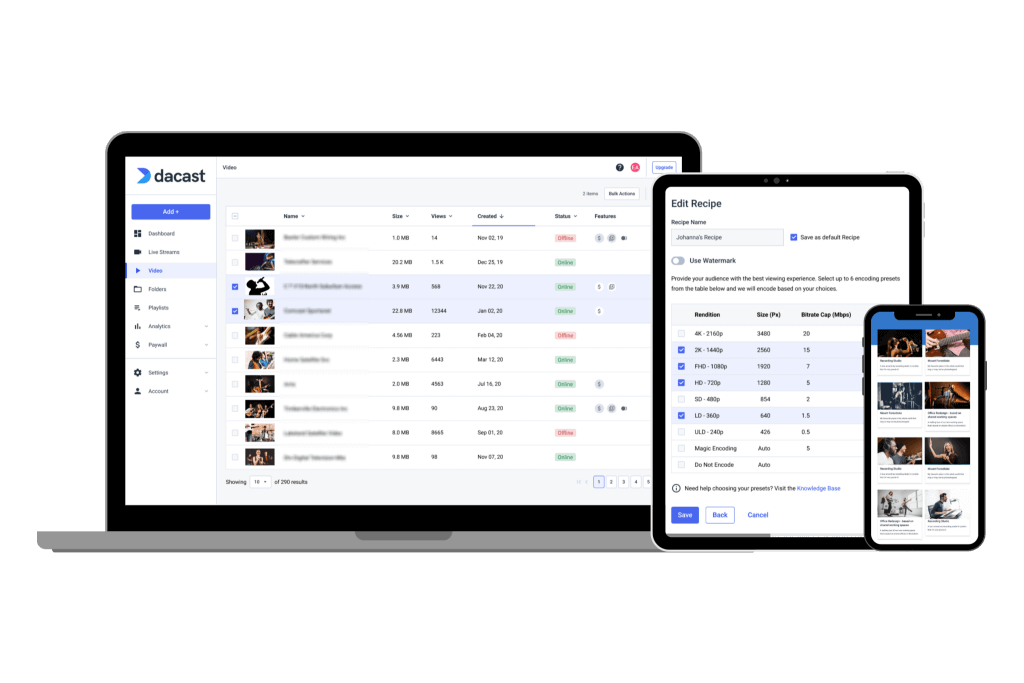
A VOD monetization platform will include tools for video hosting, monetization, player customization, easy embedding, advanced security, and more.
A great way to monetize video content is to build a branded VOD video streaming platform.
Our VOD hosting platform is a media distribution system that hosts and shares content online. In other words, it’s a reserved internet property where visitors can directly access your content.
It requires a fast and easy-to-navigate website, where content can be delivered to almost any device. The strengths of having your own online video platform are setting your own prices, maintaining content distribution control, and adjusting your video marketing strategy based on user feedback and market demand.
Trying to build a VOD platform is a lot of work. You also have to invest in marketing the platform well. Partnering with Dacast simplifies the process of launching your own VOD platform. Dacast provides a robust, all-in-one streaming solution with the infrastructure, tools, and expert support needed to get your platform up and running quickly. With Dacast, you benefit from advanced features like built-in monetization options (including SVOD, TVOD, and AVOD), customizable video players, content protection with DRM and password controls, detailed analytics, and seamless embedding across devices. Whether you’re a content creator, educator, or business, Dacast empowers you to take full control of your video content and revenue strategy—all under your own brand.
However, the biggest advantage of building a VOD platform is that you have full control over the viewing experience and the monetization as well.
If you haven’t already, consider adding a paywall to charge users for access to your existing VOD library. Subscription models are an ideal way to get started with video monetization. Once the content is created, you can keep adding to your library and building your brand.
As your following continues to grow, so do your earnings. As a result, even a small (but dedicated) audience can generate substantial income.
The best way is to use a hybrid monetization model that’s a mix of PPV, subscriptions, and advertising. This way, you can attract audiences of all three segments and drive maximum revenues.
Get Your Content in Front of More Eyes
Regarding video monetization, the more people see your content, the better. One of the best ways to increase your reach is by partnering with an OTT provider with a proven video distribution network.
Over-the-top (OTT) platform technology allows viewers to access content on various equipment, including computers, mobile devices, gaming consoles, and smart TVs (Roku, Amazon Fire TV, etc.).
Rather than being limited to proprietary broadcast networks (like cable or satellite), OTT utilizes the public internet for end-to-end transmission. So long as audiences have a connection and compatible device, they can stream OTT content, and the provider can monetize their over-the-top content.
What Kind of Video Content Can I Monetize?
After learning how to monetize videos, you might wonder which content monetization platforms can help you achieve your goals, which software solution would make the best video monetization platform for your needs, and what type of content is best for video monetization.
The video content industry is growing exponentially now, meaning viewers are willing to pay a fee to access videos of all genres.
When thinking about monetization strategies, it’s important to match your content format with the right revenue model. For example, podcasts, daily vlogs, and gaming content work well with ad-based monetization (AVOD) because they attract frequent engagement and a wide audience. Tutorials, educational series, and economy or money-saving hacks are better suited for subscriptions (SVOD), since viewers are willing to pay for structured knowledge or ongoing advice.
Music-related video content, exclusive interviews, or live events often fit best with transactional models (TVOD), where fans purchase one-off access. Product reviews and short video clips about trending gadgets can also generate strong income through affiliate links and brand partnerships. Meanwhile, commentary on current affairs can combine free ad-supported videos with premium paid deep dives, creating a hybrid model that captures both reach and recurring revenue.
Regardless of the video monetization video platform you choose to monetize your streaming videos, make sure you understand the basics of how copyright laws work. Most monetization video platforms maintain strict rules regarding plagiarism, copyrights, and spam.
That’s especially important if you utilize content, video, or audio that isn’t your original creation. Secondly, ensure your content is always mindful of your target audience’s religious and cultural sensitivities.
Original, well-researched, and engaging content is always the best candidate for top video monetization platforms. It’s also the best way to ensure you maximize views and revenue for the videos you work so hard to create.
How to Monetize Videos Without YouTube
In 2026, while platforms like YouTube continue to offer vast reach, they present challenges for creators seeking to monetize their content effectively. YouTube’s monetization policies require creators to meet specific thresholds—such as 1,000 subscribers and 4,000 watch hours in the past 12 months—to join the YouTube Partner Program.
Even upon meeting these criteria, creators often face limited control over ad placements and revenue shares, with YouTube retaining a significant portion of the earnings.
Additionally, YouTube’s frequent policy changes can impact creators’ income stability. For instance, updates to content guidelines or shifts in algorithm preferences can affect video visibility and monetization eligibility. Such unpredictability makes it challenging for creators to rely solely on these platforms for consistent revenue.
To mitigate these challenges, many creators are turning to alternative monetization strategies. Subscription-based models, such as Patreon, allow creators to earn recurring revenue by offering exclusive content to their most loyal fans.
Patreon has introduced features like subscription gifting and discounts to help creators expand their subscriber base and increase earnings.
Despite these platforms’ benefits, hosting videos on your own website remains advantageous for maximizing profits, ensuring content security, and achieving scalability. By utilizing established content monetization platforms or online video streaming service providers, creators can maintain greater control over their distribution and revenue streams, leading to a more sustainable and predictable income.
What is a Video Paywall?
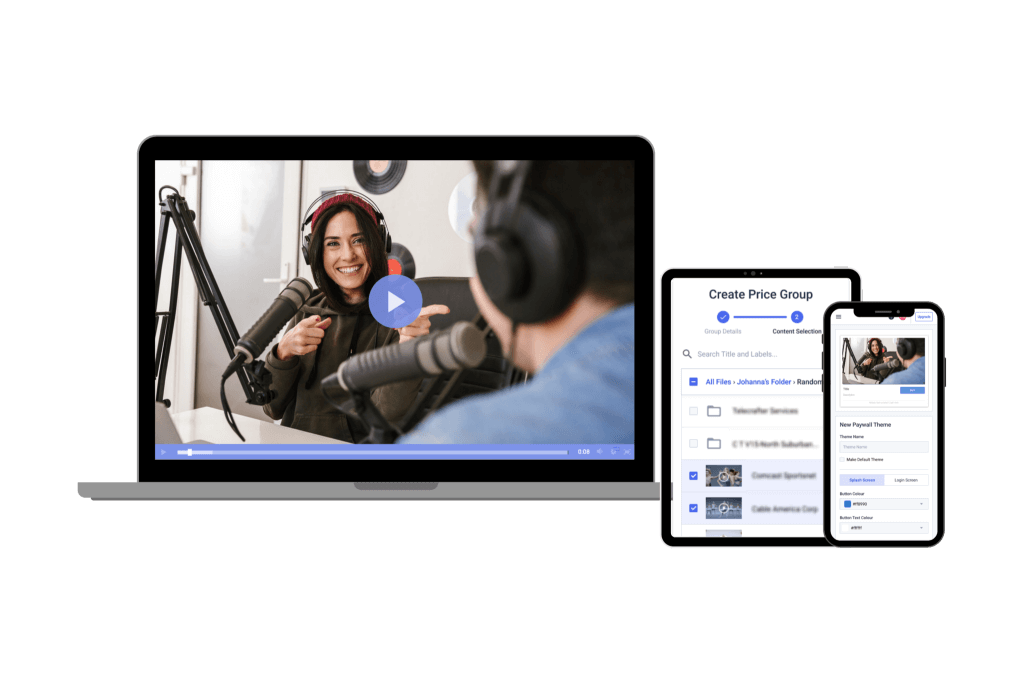
If you want to charge subscribers for content, there has to be a method in place to restrict access. That’s where a video paywall comes into play, acting as a digital payment barrier to control the flow of videos.
You need a video paywall for SVOD and TVOD monetization. It restricts free access to digital content by requiring a viewer to purchase the video or pay for a subscription to gain access to the content.
Video paywalls fit nicely with subscription models as viewers can have their accounts for library access while broadcasters earn steady recurring income. Most brands using paywalls offer free access to some content but block others with popups or login prompts. This type of streaming setup is known as a soft paywall.
Soft paywalls are an excellent way to monetize your content and align well with most streaming solutions. In addition, you can test how viewers will react to ads – without completely alienating your audience.
Setups, where no free content is offered, are called hard paywalls. Although hard paywalls can generate more revenue in the long run, you need a solid user base to make it work. Otherwise, casual visitors will look for free content elsewhere.
Hard paywalls may also limit the number of advertisers you can attract since you have a smaller audience to market to. The optimal paywall strategy is to use a combination of both. Offer free content for some users and paid subscriptions to others. Any particular video or everyday videos can be shared with general audiences, while premium content is reserved for members who opt to pay.
Video paywalls are the heart of robust video monetization strategies and offer solid ROI when implemented correctly.
Quick Overview of the 10 Best Video Monetization Platforms
| Platform | Best For | Audience | Monetization Methods | Pricing | Pros | Cons |
| Cleeng | Subscriber-based monetization | Creators building loyal subscriber bases | SVOD, PPV, live events | From $0.277/subscriber | Strong retention tools | Limited beyond SVOD |
| Muvi | All-in-one monetization (incl. products) | Creators integrating video and product sales | SVOD, AVOD, PPV, eCommerce | From $399/month | Full-stack platform | High startup cost |
| Lightcast | Cross-platform content delivery | Businesses, nonprofits, churches | SVOD, AVOD, PPV | Custom pricing + 20% fee | Broad reach options | High transaction fees |
| InPlayer | Live and music-based content | Music creators, event streamers | PPV, subscriptions | Not publicly listed | Event paywalls | Lack of pricing clarity |
| Dacast | Easy streaming for businesses | Broadcasters, SMBs | PPV, SVOD, ad support | From $39/month | Scalable streaming | Functional interface over flashy design |
| Kaltura | Feature-rich enterprise solution | Enterprises, universities | SVOD, AVOD, live video | From $5,400/year | Deep functionality | Requires tech skills |
| Brightcove | Large-scale, multistreaming | Large enterprises, media companies | AVOD, SVOD, live streaming | Custom pricing | Professional-grade features | Premium pricing |
| Cincopa | Media + product experiences | Creators using video with e-commerce | AVOD, PPV, product integration | From $25/month | Multimedia support | Not ideal for large scale |
| Vimeo | Simplicity and branding | Creators, educators, businesses | SVOD, rentals, live video | From $12/month | Clean UI, no ads | Fewer advanced features |
| Uscreen | Community-based memberships | Creators building subscription communities | SVOD, PPV, memberships | From $149/month + $1.99/subscriber | Built-in tools for community | Costs rise with growth |
Key Differences Between The Video Monetization Platforms
| Platform | Ease of Use | Monetization Models Supported | Ad Formats | Security / DRM | OTT / App Store Publishing | Integrations | Pricing Range (Est.) | Niche Recommendation |
| Cleeng | Moderate | SVOD, TVOD | Limited (focus on access control) | Advanced fraud prevention, AI tools | Requires custom development | SRM, segmentation, multi‑language, payments | From ~$0.277/subscriber | Media publishers or event organizers needing subscriber loyalty management and reducing churn. |
| Muvi | Easy | SVOD, TVOD, AVOD, Hybrid, E‑commerce | Pre-, mid-, post-roll; SSAI/CSAI ad insertion | Basic to advanced DRM depending on tier | Native apps for web, mobile, TV | E‑commerce, coupons, vouchers, paywall, multiple currencies | From $399/month | Creators blending video and physical product sales—perfect for creators building merch-based revenue. |
| Lightcast | Moderate | SVOD, TVOD, AVOD | Multiple formats | DRM, token protection | Supports branded OTT apps | Media management, fundraising tools | Custom pricing + 20% transaction fee | Organizations or broadcasters needing all-in-one OTT solutions with integrated fundraising. |
| InPlayer | Easy–Moderate | SVOD, TVOD | No native ads | Robust: paywall, geo-pricing, coupons | No native OTT; API-based | Stripe, paywall auth, multi-currency, CRM data capture | Not publicly listed | Musicians or live event promoters seeking secure, flexible paywalls and global sales. |
| Dacast | Easy | TVOD, AVOD, (Pay-per-minute) | Via ad integrations | Paywalls, tokenization, DRM | Limited out-of-box support | API, Zoom, analytics, global CDN | $39–$188/month tiered | Small-to-mid businesses or live event hosts who need affordable, robust live monetization. |
| Kaltura | Moderate | SVOD, TVOD, AVOD | Advanced | Enterprise-grade DRM, SSO | Kaltura Cloud OTT | LMS, CMS, SSO, analytics | Enterprise-level pricing | Enterprises, universities, or corporations needing deep integration, secure streaming, training, webinars. |
| Brightcove | Moderate | SVOD, TVOD, AVOD | VAST, VPAID, SSAI, pre/mid/post-roll | Studio-grade DRM (Widevine, FairPlay, PlayReady) | Full OTT publishing capabilities | Salesforce, Adobe, CMSs, analytics | Enterprise pricing (custom) | Studios and broadcasters requiring advanced ad formats, full OTT stack, and global delivery. |
| Cincopa | Easy | TVOD, limited AVOD/SVOD | Limited native ad support | Basic (token-based links) | No direct OTT support | WordPress, CRMs, marketing tools | $25+/month (variable) | Small businesses or bloggers needing quick video sales or portfolios with minimal setup. |
| Vimeo OTT | Easy | SVOD, TVOD, AVOD (enterprise) | Basic; ad support for enterprise only | Basic to upgraded DRM on higher tiers | Strong OTT app development on upper tiers | Shopify, Mailchimp, API, global payments | $20–$108/month plus per-subscriber fees | Indie creators or niche studios wanting branded apps and flexible monetization with lower barriers. |
| Uscreen | Easy | SVOD, TVOD, Hybrid | Limited ad support | Moderate security (password, geo-block) | Full OTT publishing | Shopify, Zoom, Mailchimp, Zapier, API | $199–$599/month + per-subscriber fees | Educators, fitness instructors, coaches launching subscription-based video services with marketing tools. |
Comparing All-in-One Platforms: Dacast vs. Other Solutions
Now that you know about the benefits of video monetization, the next step is choosing the best way to monetize videos. To do this, you must select a video hosting site that meets your needs. Keep in mind that some online video platforms offer native tools for monetization while others include partial or no options at all. In this case, you’ll need third-party plugins or tools to complete transactions.
Broadcasters should also review pricing and feature sets for comparable packages. Several platforms include built-in monetization options but only for enterprise-grade bundles or the most expensive plans. Keeping these ideas in mind, here is our comparison of the ten best video content monetization platforms to consider in 2026.
1. Cleeng

The first video monetization platform on our list is Cleeng – a subscription management video platform that allows you to sell and promote your video content and maintain your audience.
It supports two monetization methods – subscription-based and transactional video on demand – and comes with several flexible features like paywall options available for pay-per-view (PPV) live streaming and video-on-demand subscriptions.
What sets this video monetization platform apart from the rest is its use of AI for payments, customer support, and market segmentation. This makes it easier for you to stay proactive about your content creation business.
Also, Cleeng includes multi-language support and authentication tools for content integrity and fraud prevention.
NOTE: Cleeng works alongside video hosting software as a plugin or integration.
Pricing plans:
- Pro: Free until you reach 10k subscribers
- Enterprise: modular pricing for high volume businesses with unique needs. Starts at a few cents per subscriber.
2. Muvi
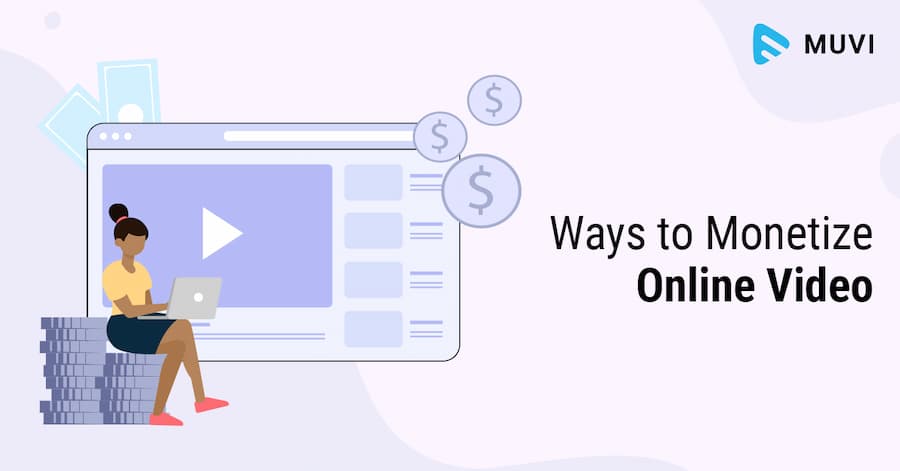
Next in our video monetization platform comparison is Muvi, an OTT-focused online video platform. But, Muvi is more than just a video monetization platform – it’s a one-stop streaming service that allows you to share video content, monetize it, and sell physical products.
It supports live streaming and on-demand video content, including a native video player and video monetization tools. The available monetization methods include AVOD, SVOD, and PPV as well as Muvi Kart, for selling items.
This platform allows you to stream video content globally effortlessly as it takes care of everything, from IT and tech features to payments. It’s highly customizable to cater to everyone’s needs and allows you to share and monetize your video content on popular social media platforms like Facebook and Instagram.
Muvi’s customization features and effortless use allowed the Fort Smith International Film Festival to successfully stream and manage movies across various rooms.
Muvi’s paywall implementation works with all major advertising, PPV, and subscription models but is less secure than other platforms. For example, there are no geographic and referrer restrictions and limited password protection.
Nonetheless, the platform’s overall security is at a high level. It comes with several top-notch security features like DRM protection and watermarks.
Pricing plans:
Muvi’s offers various pricing plans per each product.
Muvi One:
- Standard: from $339/month
- Professional: from $1274/month
- Enterprise: from $3315/month
- Ultimate: Starts from $10,000/month.
Muvi One comes with Alie – World’s First Streaming Focused AI Engine.
Muvi Live:
- Standard: from $84/month
- Professional: from $254/month
- Enterprise: from $679/month.
Muvi Flex:
- Standard: from $169/month
- Professional: from $764/month
- Enterprise: from $2464/month
Muvi Playout:
- Standard: $169/month
- Professional: $424/month
- Enterprise: $1699/month
Muvi Player SDK:
- Pay As You Go: $0/month + $0.001/view. The first 100 views are free.
- Enterprise (SDK for one platform): $499/month + $0.001/view with 100.000 views per month free. $99/month per additional platform.
Muvi TV:
- Standard: $9/month + 9% flat commission.
3. Lightcast
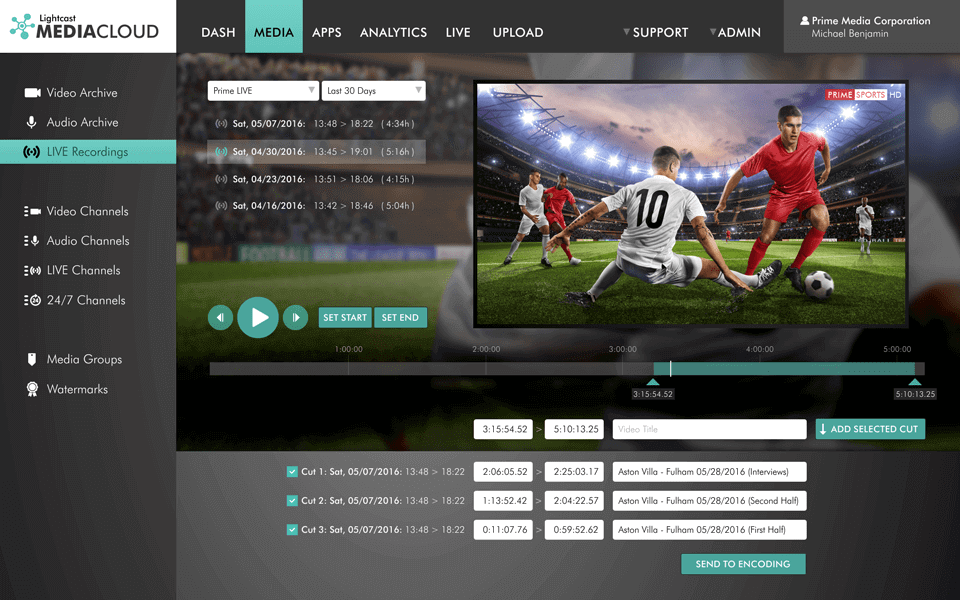
Lightcast is an easy-to-use media hosting, management, and streaming platform that allows broadcasters and organizations to stream their video content across different digital channels. It also allows them to develop their mobile apps and custom SmartTV applications by providing a variety of OTT and video hosting services.
This video monetization platform automates various content streams, including live streaming, social media, and advertising. It’s suitable for various types of broadcasters, including businesses, media agencies, religious organizations, fundraising organizations, and educational institutions as it provides them the tools and technology they need to effectively reach their audience. However, it’s not the right match for individuals, a.k.a. content creators.
Lightcast combines various security features, like DRM protection, token security, and encryption, PCI compliance to ensure content safety.
While Lightcast supports all major monetization options, including SVOD, TVOD, and AVOD, as well as fundraising tools, they’re not available in all pricing plans.
Pricing plans:
- Power: $499/mo* (*$5,990 Paid Annually)
- PowerX: $833/mo*(*$9,990 Paid Annually)
- PowerXL: $1499/mo* (*$17,990 Paid Annually)
- Signature: custom
4. InPlayer
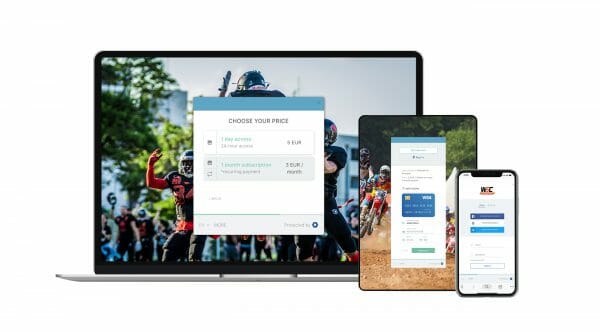
Like Cleeng, InPlayer is a top video content monetization platform and paywall solution for pay-per-view (PPV) and subscription-based revenue models. However, this one is tailored for music-oriented creators. With it, you can sell music online in various ways, including streaming audio content, monetizing music videos, selling tickets, and managing subscribers.
The InPlayer solution includes coupons, geoblocking, multiple currency options, and custom features like paying with social media outreach (a “tweet,” “like,” etc.). InPlayer uses Stripe to process payments.
Additionally, it comprises various authentication and security features like in-app authentication for payments, social sign-in services, and custom registration fields for subscribers. And, it includes API access and a native CRM system for capturing user data.
Pricing:
InPlayer no longer has pricing information published on its website, but they’ve used a revenue-sharing subscription model in the past.
5. Dacast

Among all the content monetization platforms out there, Dacast stands out for several reasons. First, Dacast is a video-on-demand platform supporting pay-per-view (PPV) subscriptions, and advertising monetization models. Streams are delivered via the top-tier CDN service with user paywalls integrated directly into Dacast’s white-label video player.
Our subscription management system offers weekly, monthly, quarterly, and biannual renewal options, while our paywall solution accepts 135 different currencies (and counting) and is translated into ten other languages.
With our video monetizer model, Technical assistance is available 24/7, and we offer professional support services for live events, hosted pages, and software development projects. That makes Dacast the best video monetization platform for broadcasters like you.
Streaming media audiences voted Dacast the best SMB online video platform of 2019 and runner-up for educational video delivery. In addition, broadcasters have nominated (and placed Dacast in the top three) for multiple award categories six years in a row!
Pricing plans:
Live streaming pricing starts at just $39/month for the Starter plan and includes:
- Starter Plan: $39/month (includes 2.4 TB of bandwidth & 500 GB of storage)
- Event Plan: $63/month (includes 6 TB of bandwidth upfront and 250 GB of storage)
- Scale Plan: $165/month (includes 24 TB of bandwidth per year and 2 TB of storage)
- Custom plan: Contact us for custom pricing plans
The most notable of Dacast’s online video platform features are:
- Live streaming and Video on Demand are included in all plans
- Wide range of video monetization tools
- Top-notch dynamic token security
- Low-latency video streaming
- Ad Network Integration with Ad Insertion
- Video Paywalls
- Unlimited Viewers and Live Channels
- Multi-user access on Scale and Custom plans
- Zoom live streaming integration for meetings and live events in real-time
- Expo 2.0 galleries video portal for immersive video experiences
- Mobile streaming support
- Real-time Analytics
- Ad-free Streaming
Real-World Case Studies
To see how broadcasters are using these features in the real world, here are three brief case studies showcasing how organizations across sports, education, and community broadcasting have successfully monetized their content using Dacast.
Case Study 1: World Players of Handball — Sports Monetization (Pay-Per-View)
Sector: Sports (Handball)
Monetization Model: Live and on-demand content using integrated Paywall + VOD
Approach & Outcome: To expand handball’s reach while generating revenue, World Players of Handball implemented Dacast’s built-in paywall within their streaming player. This allowed them to seamlessly offer both free and monetized content globally at low cost. They now broadcast to over 10 countries—including the UK, Canada, and Australia—leveraging Dacast’s CDN for high-quality delivery.
Case Study 2: Pittsfield Community Television (PCTV) – Local Programming & Pay-Per-View
Sector: Community Television (Local Sports & Programming)
Monetization Model: Pay‑Per‑View live streaming for local content
Approach & Outcome: PCTV used Dacast to extend its reach beyond cable platforms, offering local programming and live sports online. With pay-per-view enabled, they successfully attracted new audiences and additional revenue streams from online viewers.
Case Study 3: Striv.TV (High Schools) – Education / School Sports Streaming
Sector: Education (High School Sports & Events)
Monetization Model: Live streaming + VOD (often via subscription or school partnerships)
Approach & Outcome: Striv.TV provides streaming services to over 80 U.S. high schools, enabling them to broadcast live events and on-demand content. While the specific revenue model (e.g., subscriptions, sponsorship) may vary by school, the platform empowers schools to engage wider audiences—boosting viewership and potential monetization.
6. Kaltura

Kaltura is an open-source online video platform that provides a highly customizable streaming experience. Within these customizations, broadcasters can integrate various video monetizer tools and systems.
Creators can choose between various monetization methods, including AVOD, TVOD, and SVOD monetization models.
It promises to deliver extraordinary service for whatever streaming needs you may have, from virtual classrooms to webinars to events, to help boost your engagement, reach, and ROI. It also features a dedicated video portal for users to easily access content.
Pricing plans :
The pricing structure of Kaltura is complex as each solution (virtual classrooms, events, webinars, etc) has a separate price.
These include but are not limited to:
- Business: $250/month when billed annually)
- Enterprise: Custom pricing
- Basic: $17/month when billed annually; up to 8 participants per session and 8 hrs of cloud recording
- Pro: $50/month when billed annually; up to 25 participants per session and 15 hrs of cloud recording
- Business: $115/month when billed annually; up to 100 participants per session and up to 25 hrs of cloud recording
- Business Plus: Custom pricing for up to 300 participants per session, unlimited sessions and custom storage needs
- Annual discounts: Discounted pricing packages available for any scale and use-case, enterprise SLA, and developer support
- Limited trial account: $1 for $100 worth of credits for 30 days for testing and experimentation, with no commitments
- Pay as you go – You pay only for what you use at these credit levels.
Other services include virtual events, video portal town halls, video messaging, meetings, and more.
7. Brightcove
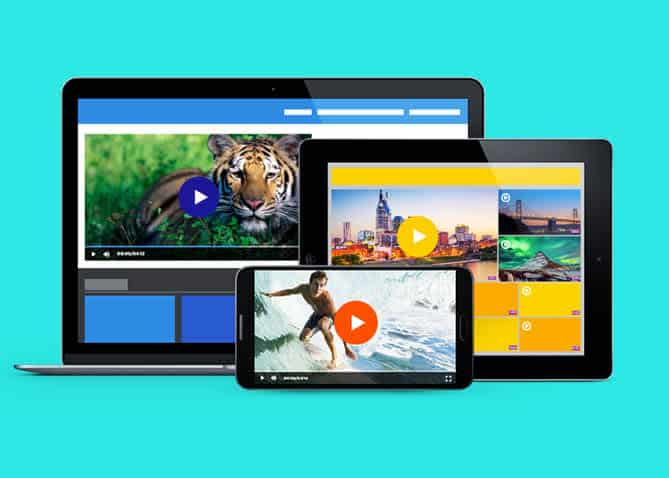
Brightcove is a high-end streaming solution with a built-in video monetization platform. It allows smooth video streaming across the web, mobile devices, and smart TVs. It also supports multiple video monetization methods, including AVOD, SVOD, and TVOD. And, it provides users with marketing tools and analytics for the audience reached.
The advertising features from Brightcove are pretty innovative. This platform offers server-side ad insertion, allowing it to serve ads even when viewers use ad blockers. It also provides ad cue points for pre-, mid-, and post-roll advertisements.
Another remarkable aspect of Brightcove’s video monetization is that it uses metadata to serve targeted video ads. But, that’s not all.
Brightcove also comes with strong security features like IP restriction, studio-grade content protection, and URL tokenization. Moreover, it follows the ISO 27001 standards and is certified by the CSA STAR registry and Digital Production Partnership (DPP).
Marketing Studio
- Available in multiple tiers: Starter, Essential, and Premium.
- Each tier varies in features like analytics, integrations, interactivity, and support.
- Live-streaming is an optional add-on across all tiers.
- Pricing is not publicly listed – requires contacting Brightcove’s sales team.
Communications Studio
- Offered in Essential and Premium tiers.
- Designed for internal and external communications use cases.
- Features vary by tier in analytics, viewer engagement, and live-streaming limits.
- Pricing is only available through direct inquiry with sales.
Media Studio
- Built for broadcasters and OTT media companies.
- Tiers: Essential and Premium.
- Premium includes advanced features like DRM, offline playback, dynamic delivery rules, and granular analytics.
- No public pricing available – must request a custom quote.
OTT Flow (Powered by Accedo)
- Turnkey OTT solution for launching streaming apps and services.
- Ad-supported (AVOD) services start at $10,000 per month.
- Subscription-based (SVOD) services start at $15,000 per month.
Zencoder (Video Encoding Platform)
- Test Plan: Free, limited to 5-second output clips.
- Pay-as-you-go Plan: Starts at $40 per month.
- Launch Plan: $300 per month (includes 1,000 output minutes).
- Traction Plan: $2,000 per month (includes 10,000 output minutes).
- Growth Plan: Custom pricing for 100,000+ minutes.
- Enterprise Plan: Custom pricing for large-scale encoding needs.
Ad Monetization Services
- Brightcove offers managed ad monetization for video content.
- Supports SSAI/CSAI integrations and uses SpringServe/Magnite for optimization.
- No upfront cost listed – Brightcove typically retains a revenue share from ad earnings.
Please contact their sales department to find out the pricing structure for their live streaming features.
8. Cincopa
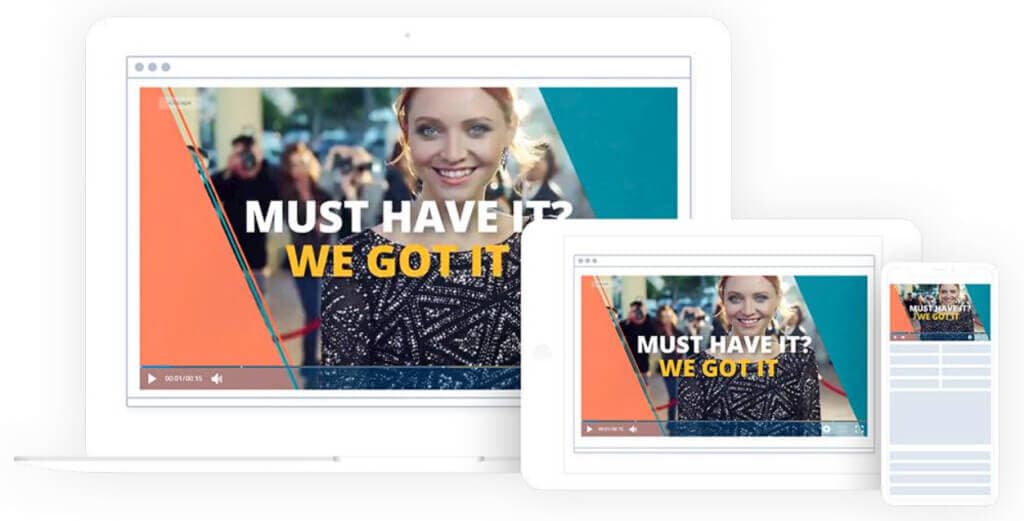
Cincopa is a multimedia hosting software with a built-in video monetization platform for generating live and on-demand content revenue. It supports two video monetization methods – subscriptions and advertising.
You can create tiered subscription plans and charge a one-time fee for various types of content and access rights. When it comes to the ads, you have full control over your ads’ design, placement, and frequency. Like Brightcove, this platform also supports pre-, mid-, and post-roll ad insertion.
Cincopa also offers Paygate API, which helps users customize their monetization methods to fit their needs best. Additionally, it supports e-commerce integration which allows creators to add multimedia content to their websites for improved product/service promotion.
Pricing plans:
Cincopa offers four pricing plans for multimedia hosting:
- Plus: $25/month; 50 videos, 75 audio/podcast files, 1 TB monthly traffic
- Corporate: $99/month; 250 videos, 300 audio/podcast files, 2 TB monthly traffic
- Enterprise: $350/month; unlimited videos, audio/podcast files, and monthly traffic
- Custom Enterprise: Custom pricing; dedicated account manager, SSO
9. Vimeo OTT
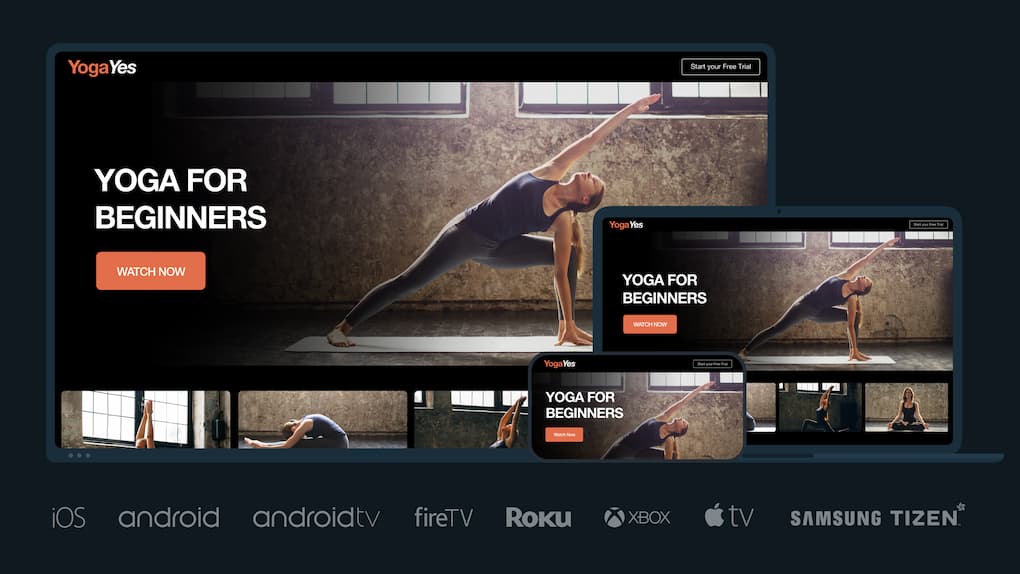
Vimeo acquired Livestream in 2017, which gave Vimeo the ability to offer live video streaming solutions. Vimeo’s OTT solution is one of the three advanced solutions that Vimeo has available for streaming service providers under the Livestream name.
Vimeo OTT is a specialized video hosting solution designed specifically for broadcasters using the OTT streaming service business model. Vimeo OTT supports TVOD, AVOD, and SVOD monetization models.
Pricing plans:
Vimeo Livestream offers its OTT product on a completely separate payment structure:
1) Vimeo OTT:
- Vimeo’s OTT solution is priced separately from the regular Vimeo packages. There are two plans: Starter and Enterprise.
- Starter Pricing: $1/subscriber per month
- Enterprise Pricing: Please contact Vimeo for custom pricing information
Vimeo also diversifies its offering with video hosting plans that are suitable for content creators and startups.
Pricing if billed monthly, is as follows:
- Free: $0/month; 1 GB storage, creation and editing, screen recording
- Starter: $20/month; 2TB storage, auto closed captioning, custom URLs and video player, privacy tools
- Standard: $41/month; 4 TB storage, engagement and social analytics, AI script generator, teleprompter, brand kit
- Advanced: $125/month; 10 TB storage, stream to multiple destinations, host live broadcasts and webinars, AI-generated chapters and text summaries
- Enterprise: Custom pricing; more storage and bandwidth, advanced AI capabilities, quality events, dedicated support
All plans are billed annually.
10. Uscreen

Uscreen is a TV-grade video hosting platform and software with a built-in video monetization platform. This video monetization solution is equipped with support for subscription and pay-per-view (PPV) video monetizer models and one-time purchases. It’s designed to generate revenue for OTT video streaming services like Netflix or Hulu.
You can use Uscreen to share live streams and on-demand content. It comes with built-in community-building features and offers users a dedicated app for their video library.
This all-in-one video monetization platform is an excellent choice for content creators who want to build a community-driven membership website. It’s easy to use and lets you create an easy-to-navigate video library.
All you need to do to monetize your videos with Uscreen is create a subscription site and share your live streams, on-demand video content, or 1-time events.
Pricing plans:
- Growth: $149/month
- Pro: $449/month
- Plus: Custom pricing for established creators who need full brand control across all platforms, including live streaming and live chat, with all Uscreen branding removed.
Emerging Video Monetization Platforms to Keep an Eye On
Apart from the top video monetization platforms mentioned above, there are a few promising ones to consider. Although relatively “younger”, these platforms come with features that can help you serve your video content to the right audience with ease.
Connatix
Connatix has recently merged with JW Player, aiming to create the biggest video technology and monetization platform. Make sure to keep an eye on this merging to see what it brings.
Meanwhile, Connatix, on its own, offers its unique feature – digital signal processing (DSP) tools, which can feel what consumers are interested in and recommend the most relevant video content. This will be a great advantage in a cookieless world, which internet browsing authorities try to achieve.
Apart from this, Connatix provides you with integrated easy-to-use video creation and editing tools and allows you to launch and manage your ad campaigns. It supports AVOD monetization strategy and offers custom pricing for enterprises.
VlogBox
VlogBoz is a marketing agency and video monetization platform for CTV channel owners. It’s best for creators who want to share their videos on smart TVs.
Unlike most popular monetization sites, this one helps you develop an app, launch it, and promote it, so you can start earning money from your video content more easily. It supports AVOD and SVOD monetization methods and the cost is based on a rev-share model, with prices ranging from $399 – $1,099+ per month.
8 Things to Consider When Choosing a Secure Video Monetization Platform
Choosing a video monetization platform among the many options available on the market can be hard and time-consuming. To make things easier, we’ve prepared a list of factors to consider when deciding.
- Ease of use and customization: The platform must be easy to use, with a user-friendly interface, and highly customizable. You want to have the freedom to customize and manage your video content. Look for platforms that offer customizable video players, content management systems, and automated workflows.
- Monetization methods available: Make sure the platform supports your preferred monetization model. It’s best to go for sites that support various monetization methods as this allows you to offer your audience multiple options to pay and consume your content.
- Audience type: Not all monetization platforms cater to the same type of audience. That’s why it’s important to consider which platform is best suitable for your type of audience.
- Advanced Paywall feature: Consider the payment options the platform offers consumers to make sure they have enough methods to choose from. Also, to ensure smooth finance management and a simple overview of your earnings, look for a platform with a comprehensive dashboard containing information about the most popular content, recent payments, and the average value of your orders.
- Price: Some video monetization platforms are more suitable for enterprises and agencies rather than individual video content creators. So, make sure you check the pricing page before making up your mind. Also, consider the available pricing tiers and whether they offer clear and flexible costs to support your business and audience growth.
- Simple payout options: Most platforms allow payments on your behalf, and you should look for one like that. Your income streams should be frequent, through a method that suits you, and available when you want. Consider the payout fees and keep in mind that your payment process or bank might have additional transactional fees.
- Security features: Many creators overlook the security features platforms offer, but they are some of the most important things to consider when looking for a reliable monetization platform. Go for a platform that has built-in security features like multi-factor authentication, dynamic tokens, DRM protection, encryption, and PCI compliance.
- Multi-language and currency support: Whether you broadcast internationally or attract audiences from different countries across the globe, being able to translate your content into their language and offer them to pay in their local currency is a great asset.
The Future of Video Monetization
The continuous development of AI, machine learning, blockchain, and VR/AR technologies is transforming the video monetization landscape and shaping the future of content creation.
Here’s how these trends are expected to impact platforms and creators moving forward:
AI-Powered Monetization & Personalization
Artificial intelligence and machine learning are revolutionizing video monetization by enabling smarter, more efficient ad targeting, placement, and personalization. AI tools enhance content delivery through real-time audience data analysis, allowing creators to tailor content and ads to user preferences.
Beyond targeting, AI also automates processes like thumbnail optimization, predictive pricing, and real-time upselling during live streams—maximizing revenue while keeping workflows efficient.
Blockchain for Transparency and Creator Empowerment
Blockchain technology introduces decentralization and transparency in advertising and compensation models. It helps prevent ad fraud, ensures accurate performance tracking, and allows creators to receive instant, fair compensation when their content is monetized.
By securely logging ad transactions on-chain, blockchain enhances trust between platforms, advertisers, and creators.
Flexible Monetization Models: Microtransactions, TVOD & Hybrids
With increasing demand for personalized content experiences, rigid subscription models are becoming outdated. Flexible monetization options such as microtransactions and TVOD (Transactional Video on Demand) allow users to pay only for what they watch—whether it’s a single episode or specific bonus content.
In niche sectors like sports, education, and gaming, hybrid models are gaining traction—blending subscriptions with micro-payments for exclusive perks like replays, bonus content, or personalized sessions.
Shoppable and Commerce-Integrated Video
Video content is quickly evolving into a shopping experience. Shoppable videos now include clickable product tags, allowing viewers to purchase items shown in videos or live streams instantly—without leaving the platform.
E-commerce features such as one-click purchasing and even voice-command buying are being embedded directly into video players. Livestream shopping, in particular, is emerging as a high-engagement, real-time retail channel.
Interactive Content & Gamification
Monetization is expanding beyond passive viewing into interactive experiences. Creators are incorporating clickable elements, narratives, and quizzes to boost user engagement—some behind paywalls.
Gamification is also on the rise. Video platforms are adding reward systems, such as loyalty points or achievements, to encourage more watch time. These points may be redeemable for exclusive content, perks, or merchandise, especially appealing to younger audiences.
Global Payments and Crypto Integration
To support international audiences, platforms are integrating diverse payment methods including cryptocurrency, regional wallets (like Alipay, Paytm, and M-Pesa), and multi-currency options. This reduces friction and improves accessibility across markets.
Navigating Regulation and Privacy
As monetization evolves, so do regulatory requirements. Platforms must now comply with privacy-first frameworks like GDPR, CCPA, and COPPA. Strategies that rely on first-party data and contextual targeting are replacing cookie-based tracking.
Although the exact future of video monetization remains uncertain, one thing is clear: it will become more personalized, interactive, and tech-integrated, creating new opportunities for creators and better experiences for consumers.
FAQs
1. How do I monetize my video content in 2026?
In 2026, creators can rely on video monetization platforms offering integrated analytics, payment gateways, and multi-format support. These platforms provide flexible models, user insights, and global distribution. Choose a platform that matches your content type and goals, whether you’re scaling a media business or monetizing educational or entertainment content.
2. Can short-form videos be monetized effectively?
Yes—short-form videos are perfect for ad integration, quick CTAs, and trends. Platforms now support AI in video monetization, analyzing viewer behavior to maximize revenue. These tools automatically match content with high-yield advertisers. Pairing short-form storytelling with AI-driven targeting increases ROI and delivers relevant experiences to mobile-first audiences.
3. Which video monetization platform pays the most?
Creators seeking high returns should compare video monetization with multi-currency payments support. Platforms that allow billing in local currencies increase conversions and reach. This feature is especially powerful for global audiences, reducing friction and cart abandonment. It’s a must-have for scaling paid content across regions with diverse currencies.
4. What are hybrid monetization models and when should I use them?
Understanding AVOD vs SVOD vs TVOD is crucial when building hybrid models. Combine ad-based (AVOD), subscription-based (SVOD), and transactional (TVOD) to serve different audience segments. This flexibility boosts earnings and lets you tailor offerings per content type, viewer behavior, or regional demand. Use strategically to optimize monetization potential.
5. How can I monetize live streaming events?
To scale live events, look beyond ads and tickets—choose the best monetization platform for live streaming in 2026 with adaptive streaming, interactivity, and real-time analytics. These platforms support diverse monetization types, integrated commerce, and social engagement, offering tools for both casual streamers and large-scale broadcasters with premium offerings.
6. How can I monetize videos with Dacast?
Dacast supports flexible payment models, but its true strength lies in being a secure pay-per-view streaming solution. Perfect for exclusive events, online courses, or one-time access. It allows full control over pricing, audience, and access restrictions while integrating seamlessly into your website without relying on external ad networks.
7. What is the most secure way to monetize video content?
To monetize video content securely without platform dependency, look into tools that offer encrypted playback, token-based access, and watermarking. These features ensure content isn’t shared illegally. Strong authentication and viewer restrictions protect revenue. Always balance security with user experience to keep access smooth while protecting intellectual property.
8. What is the best platform for niche audiences (sports, education, corporate training)?
Choose platforms to monetize niche content online with tools tailored to your audience. For education: integrations with LMS. For sports: live replay and stat overlays. Corporate training needs reporting and role-based access. These platforms specialize in niche delivery and outperform general video services in engagement and long-term revenue.
9. What Is the Best OTT Monetization Software for Sports Streaming?
The best platform for sports streaming should offer real-time delivery, interactive features like live chat or polls, and flexible pricing models. It must handle large audiences, support high-definition streams, and integrate seamlessly with ticketing or sponsorship tools. Reliability, scalability, and audience analytics are also essential for maximizing revenue.
Dacast is Your Top Choice for Monetizing Live and On-Demand Content
Video monetization is a catalyst for growth, profit, and sustainability. So if you’re a video content creator, claim your share of this growing trend. One of the best ways to jump on the bandwagon is to utilize a platform that supports your growth.
Dacast makes it easy to profit from live streaming content or existing video-on-demand libraries. The platform supports its users in multiple ways, from its easy-to-understand video analytics tool that seamlessly transforms data into actionable steps. Or its sturdy 24/7 user support ensures your viewers enjoy uninterrupted streaming around the clock.
Our powerful online video solution offers enterprise-grade performance, security, and monetization features, all for a single low price.
Each package includes secure video streaming, reliable performance via top-tier CDNs, and customizable video content and player management APIs. No other solution offers so much value at such an affordable price.
Dacast’s RTMP Streaming Platform provides reliable, high-quality live video delivery, giving broadcasters the tools they need for smooth and professional streaming experiences.
Providing quality content to audiences is more critical than ever, and organizations that do it well can generate substantial revenue from ads, subscriptions, and pay-per-view transactions.
Learning how to monetize video content more effectively can open up new revenue streams for your business or organization. As a video content creator or broadcaster, content monetization platforms are an essential tool that lets you make the most out of your video creations. Dacast enables you to monetize videos without extra steps or hassle, so you can focus on creating quality content for your viewers.
Take the next step in your content strategy — contact us to add video monetization. We offer a free 14-day trial without requiring long-term contracts or charging hefty setup fees. No credit card is required.
For regular live streaming tips and exclusive offers, you can also join our LinkedIn group.
Video Monetization
Monetize your Live Broadcasts, Events and Channels!
Set up as many pay-per-view streaming prices as you want on your video content. Control rates, promo codes, and viewing windows. Monetize your video content with secure, easy-to-use features. Facilitate global payments, control rates, and promos using an advanced paywall built right into the player.
No credit card required. By clicking Start Free Trial you agree to ourterms and conditions.
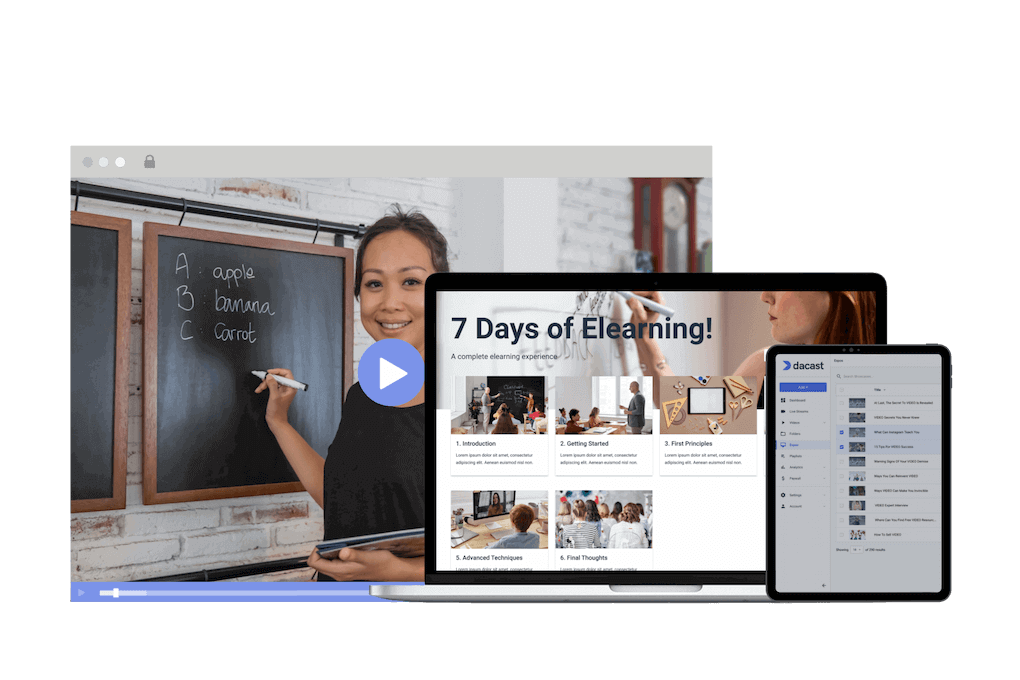
Subscription Management System
Support for SVOD, AVOD, TVOD.
Charge viewers a fee for unlimited access to your video content. Use monthly or even weekly subscription structures. Learn MoreSecure Integrated Paywall
Group Pricing, Live, and Hosted Event Support.
Secure paywall allows users to charge viewers with either a pay-per-view or subscription-based video monetization system. I'm Interested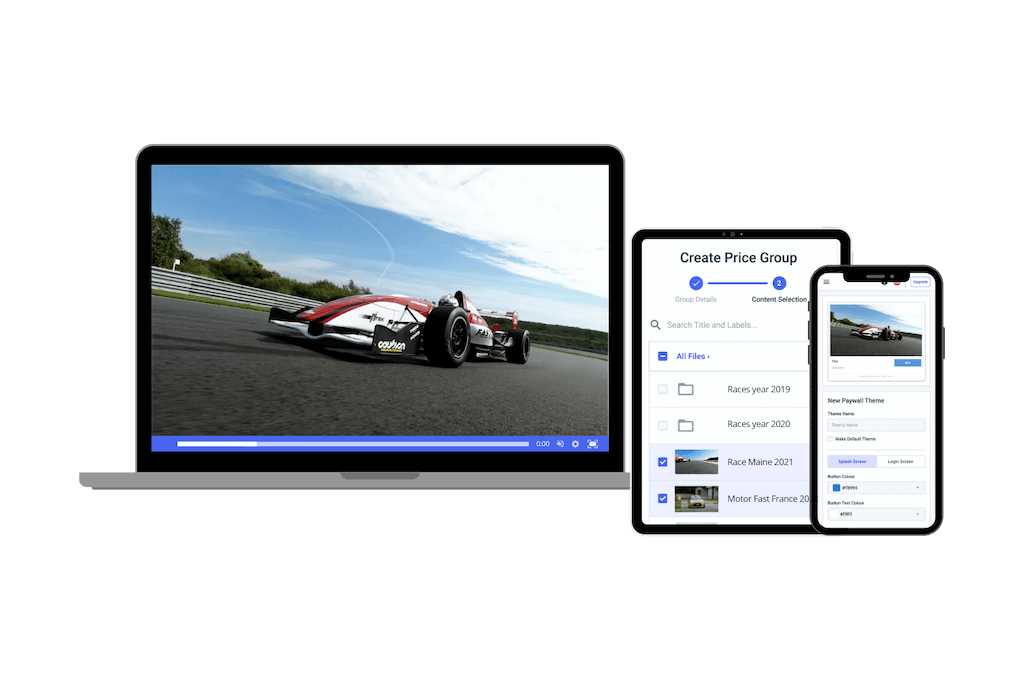
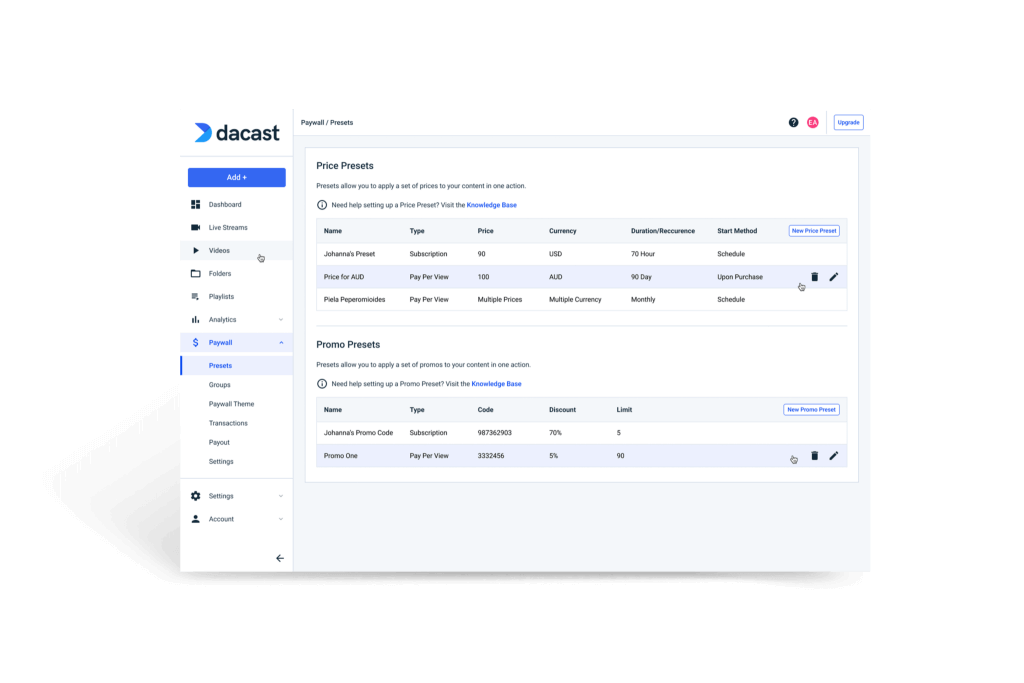
Global Currency Monetization
Engage Your Audience, Maximize Revenue.
Dacast automatically converts currency on paywalls to reflect the cost of streaming to the currency of the viewer. Get the DetailsLive Event Support
24/7 Customer Support at No Extra Cost.
Take advantage of Dacast’s live technical support to keep your paid streams running smoothly. Let's Go
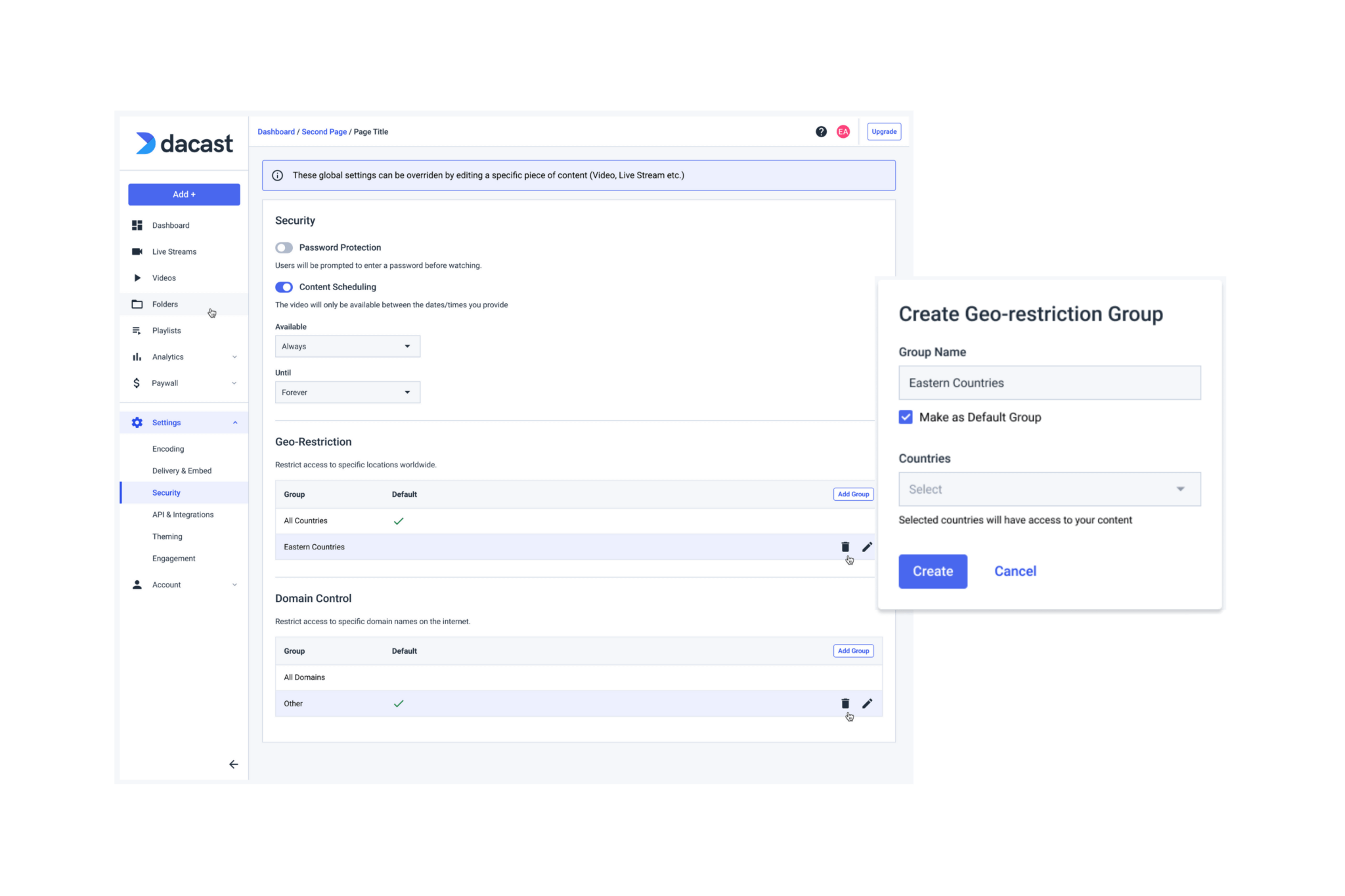
Multilingual Interface & Support
Includes 135 Currencies and 10 Languages.
Dacast automatically converts currency on paywalls to reflect the cost of streaming to the currency of the viewer. I'm InterestedGroup Pricing
One Ticket, Multiple Content Options.
Offer group pricing—or channel packages—to your viewers. This allows them to pay a one-time fee for unlimited access to your content. Explore Pricing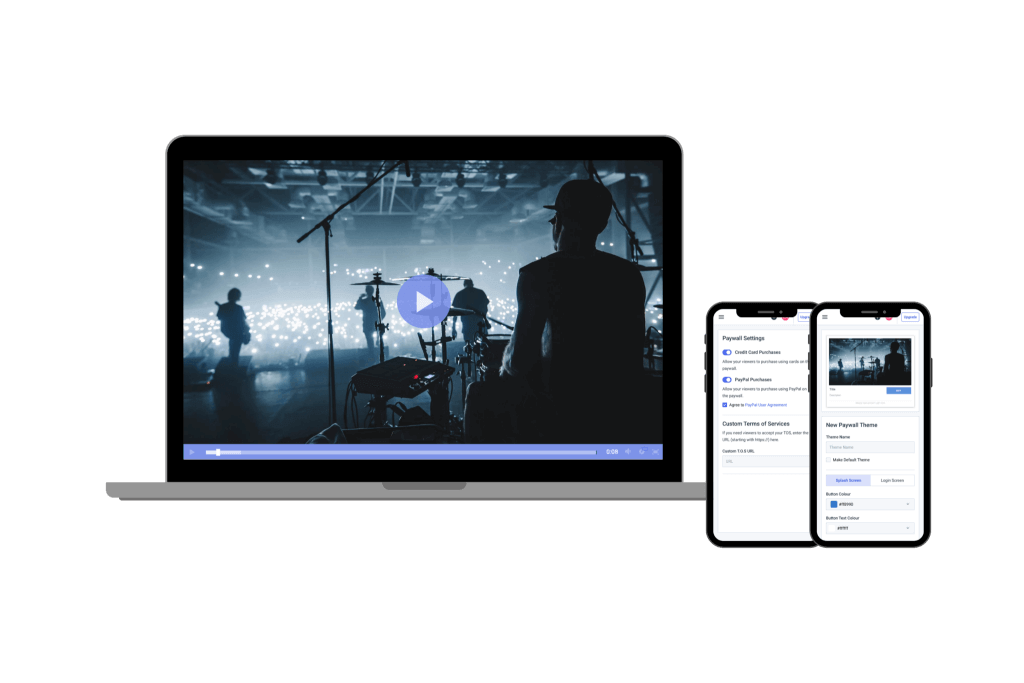
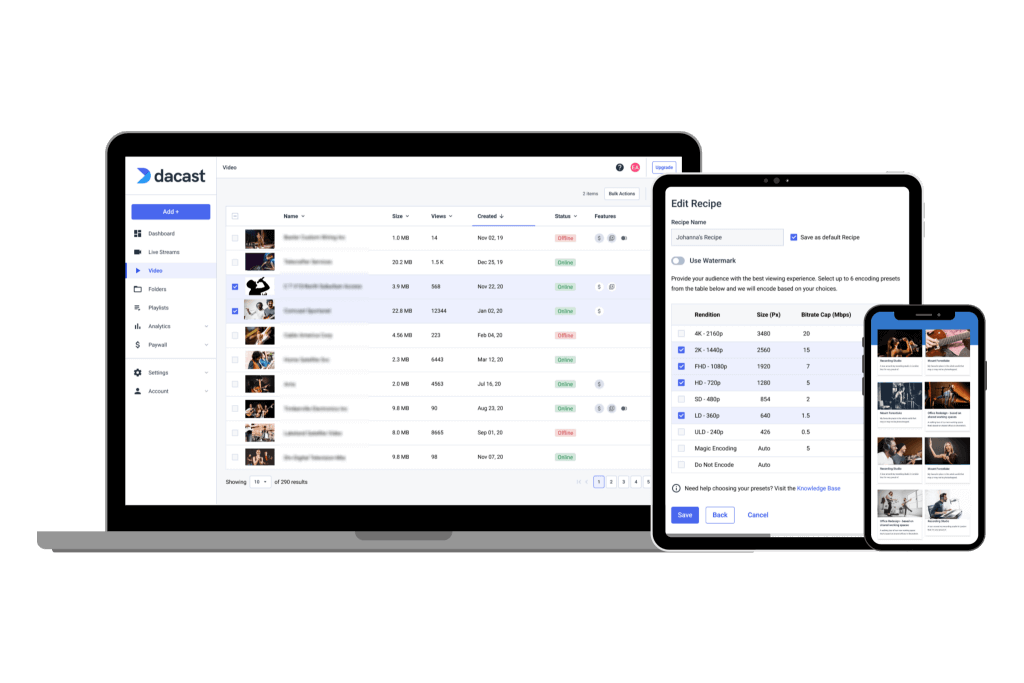
High Performance with Top Tier CDNs
Get the best streaming quality at no extra cost.
Stream live video securely with the world’s best live streaming CDNs. Access our 24/7 live streaming platform with full scalability and compatibility. Get Started“The support that Dacast offers is particularly good compared to other streaming providers, making them a clear choice for my business.”
CEO at ComeSee TV
24/7 Technical Support
The reliable help you need, when you need it
Our customer service team is here 24/7 to help you make the most of your streaming solution. Plus access a comprehensive knowledge base and dynamic online community of professionals.
SupportMost Popular Features

Mobile Streaming
Stream live to phones
Our HTML5 video player ensures compatibility with modern devices and browsers. No configuration is required, whether on a smartphone or a smart TV.
Learn more
White-label Platform
Your logo, your brand
Customize our video player with your logo and colors to put your brand front and center. The look and feel of your content are completely up to you.
Show Me How
High-Definition
Broadcast in full HD quality
Deliver pristine, quality video with multi-bitrate technology in full HD 1080p resolution to ensure that every viewer has an optimal experience.
Stream in HD
Embed Videos
Share video content
Use embed codes to easily share a video or live stream on any web page. Or, share videos with others via social media.
Get Started
Video Transcoding
Deliver your video
Use our transcoding services to offer your viewers the video quality they need according to their devices.
Let's Go
Secure Video Upload
Handle your video library
Bulk upload your video and add the layer of security your want. Access more video uploading and security tools via our advanced video hosting platform.
Upload SecurelyBest Streaming Pricing
Feature-rich and cost-competitive
Dacast is the only video platform offering high-performance live streaming and video hosting features at the best prices on the market.
Check It Out6 Reasons to Choose Dacast
Live Streaming and Video Hosting Platform
 Stream
Stream Connect
Connect Manage
Manage Measure
Measure Events
Events Business
Business Organizations
Organizations Entertainment and Media
Entertainment and Media API
API Tools
Tools Learning Center
Learning Center Support
Support Support Articles
Support Articles